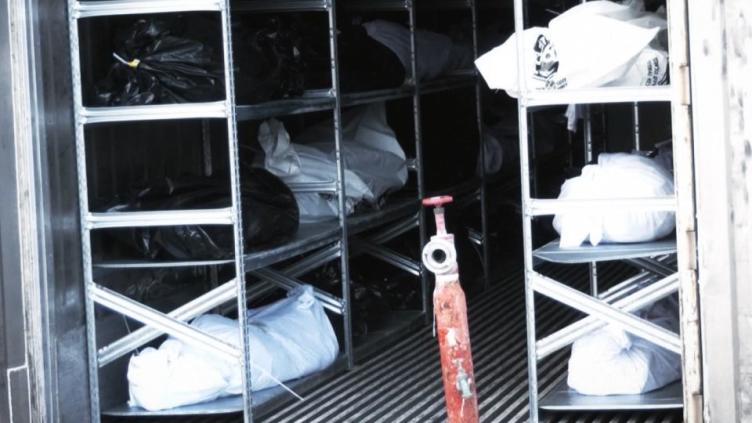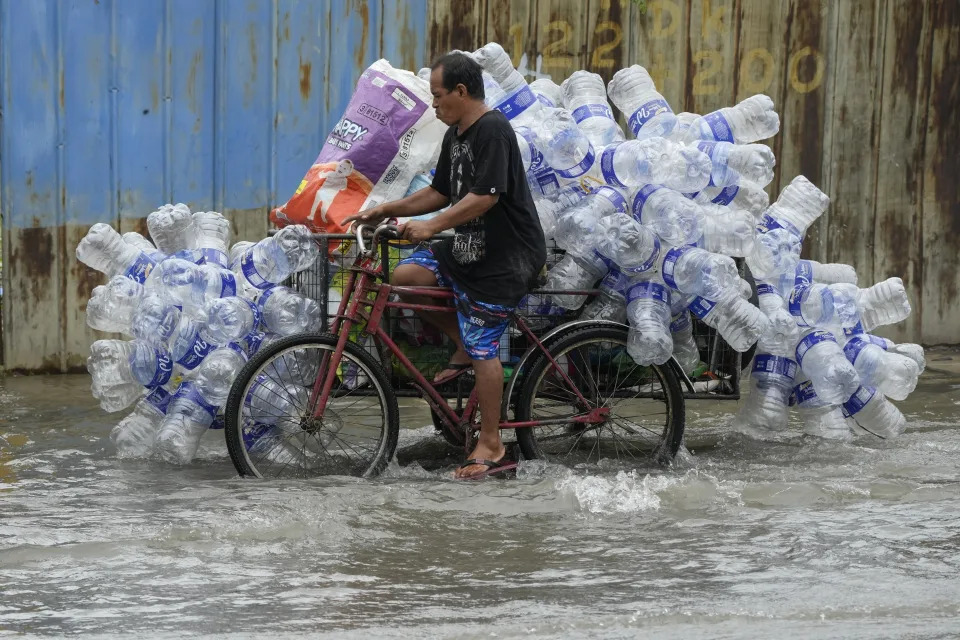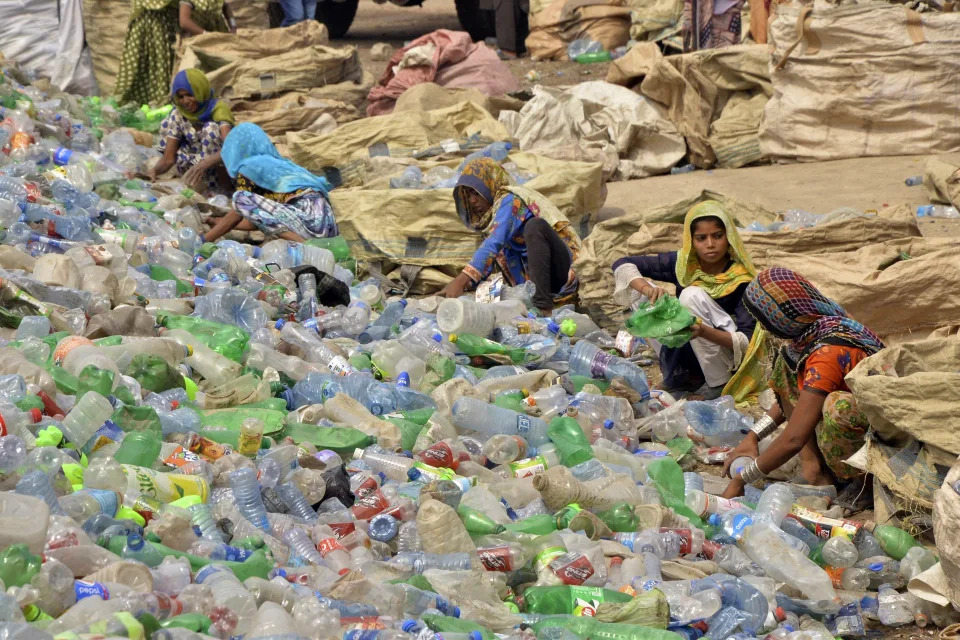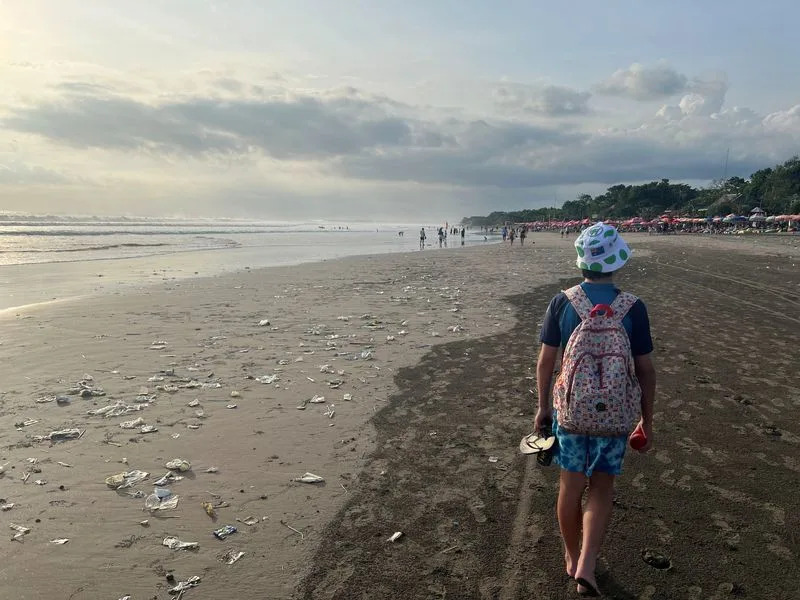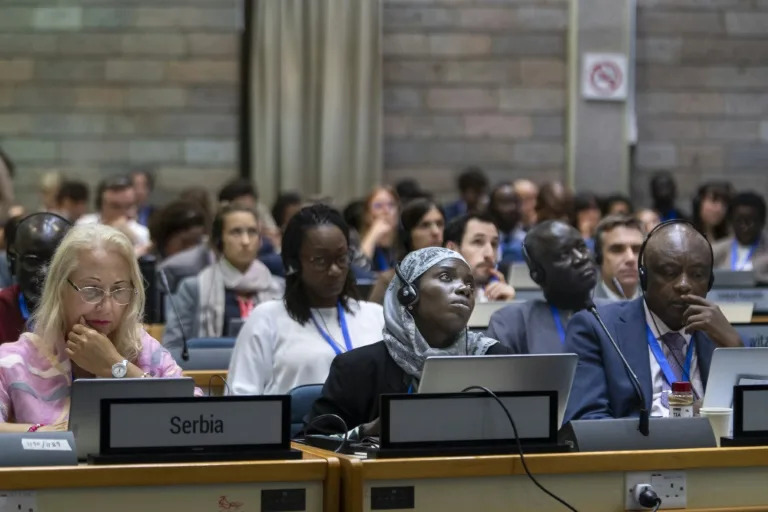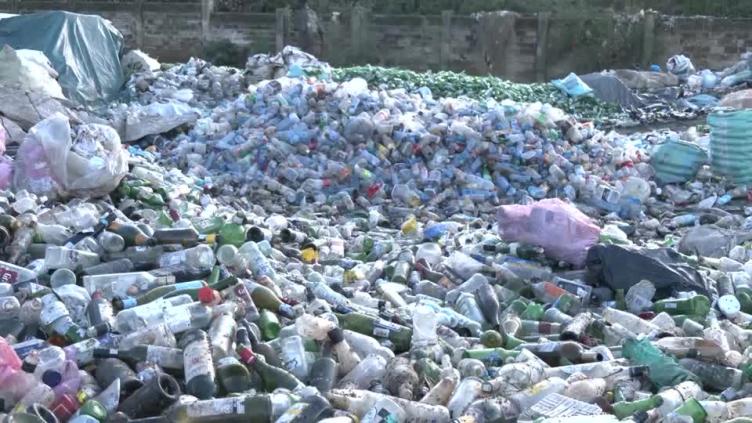Andrew Clarance in Delhi and Cherylann Mollan in Mumbai - BBC News
Tue, November 21, 2023
A camera has captured footage of the 41 workers trapped in a tunnel in India's Uttarakhand state for the first time in nine days.
The video was filmed using an endoscopic camera that was slipped inside a new pipe drilled into the tunnel on Monday.
Rescuers also used the pipe to give the workers their first hot meal in days.
So far, they had been subsisting on snacks sent through a narrower pipe inserted earlier.
The under-construction tunnel caved in after a landslide.
The incident took place on the morning of 12 November in the northern state's Uttarkashi district. Contact with the trapped men was established soon after that and they are being provided oxygen, food and water since then.
On Monday evening, the rescue operation witnessed a breakthrough after rescuers were able to push a six-inch diameter pipe through the debris inside the tunnel.
Officials slipped a small camera attached to a flexible cable into the pipe and used it to film the trapped men.
In a video released to the press, rescuers can be seen viewing the footage on a computer screen outside the tunnel.
An official asks the men to appear before the camera and smile and wave - the workers can be seen responding to the instructions.
He also tells them that they will be rescued soon and later asks them to identify themselves in front of the camera.
The unfolding drama of India's tunnel rescue mission
Rescuers to drill new tunnels for trapped India workers
Rescuers appear to be using two-way radios to communicate with the men - the video shows one of them holding a walkie-talkie in his hands.
The men, many of whom are wearing safety helmets and jackets, can be seen standing in a semi-circle near the camera.
The official then tells the men that the pipe will soon be cleaned after which water will be sent to them.
Some colleagues of the workers said they were delighted to see their friends after so many days.
"I have seen them on camera, but now I'm waiting to see them in the flesh," said Rahul Ameen, whose two friends are trapped inside.
Mr Ameen said he has been regularly visiting the tunnel to keep himself updated about the progress of the rescue operations.

The workers seen on a monitor in the control room
The new pipe is wider than the four-inch diameter pipe officials had inserted into the tunnel, hours after a portion of it caved in on 12 November.
Because of the narrowness of the pipe, only certain snacks like grams and dry fruits could be given to the workers so far. The pipe was also used to supply oxygen to them.
Officials have said that the new, wider pipe will help supply the workers with more oxygen, food and other essentials such as medicines, mobile phones and chargers.
Rescuers have already used it to give the workers their first hot meal of khichdi (a rice and lentil dish) - which was packed in bottles and sent inside.
The operation, which entered its 10th day on Tuesday, has encountered several delays and obstacles primarily due to loose soil and falling debris.
The plan is to dig a hole wide enough to accommodate a 900mm pipe, which the workers can use to crawl out of the tunnel.
However, on Monday, officials said that they were attempting to dig two more tunnels by the side of the main escape tunnel as additional escape routes.
On Sunday, federal Highways and Roads Minister Nitin Gadkari had visited the site and said that the rescue operations could go on for "two to three days".
41 workers stuck in a tunnel in India for 10th day given hot meals as rescue operation shifts gear
Associated Press
Updated Tue, November 21, 2023

This screen grab image provided by the Uttarakhand State Disaster Response Force (SDRF) shows one of the 40 workers trapped inside a collapsed tunnel in Silkyara, in the northern Indian Uttarakhand state, India, Tuesday, Nov. 21, 2023. ( SDRF via AP) (ASSOCIATED PRESS)
NEW DELHI (AP) — The 41 construction workers who have been trapped in a collapsed tunnel in northern India for over a week are finally getting hot meals Tuesday, provided through a newly installed steel pipe, as rescuers work on an alternate plan of digging toward them vertically.
The meals, made of rice and lentils, were sent through a 6-inch-(15.24 cm) pipe pushed through the rubble late Monday, said Deepa Gaur, a government spokesperson.
For the last nine days, the workers survived off of dry food sent through a narrower pipe. Oxygen is being supplied to them through a separate pipe.
Officials on Tuesday released a video, after a camera was pushed through the pipe, showing the workers in their construction hats moving around the blocked tunnel while communicating with rescuers on the ground through walkie-talkies. Their families have been growing more worried and frustrated as the rescue operation dragged on.
The tunnel collapsed in Uttarakhand state, a mountainous region that has proved a challenge to the drilling machine which broke down as rescuers attempted to dig horizontally toward the trapped workers. The machine’s high-intensity vibrations also caused more debris to fall, prompting officials to suspend rescue efforts briefly.
Currently, rescuers are creating an access road to the top of the hill from where they will dig vertically. From the vertical direction, drilling to the tunnel will take a few days and debris could fall during the digging, officials said Monday. Rescue teams will need to dig 103 meters (338 feet) downwards to reach the trapped workers — nearly double the distance.
Auhtorities said they would also continue digging horizontally from the mouth of the tunnel toward the laborers.
The workers have been trapped since Nov. 12, when a landslide caused a portion of the 4.5-kilometer (2.8-mile) tunnel they were building to collapse about 200 meters (650 feet) from the entrance.
Uttarakhand is dotted with Hindu temples, and highway and building construction has been constant to accommodate the influx of pilgrims and tourists. The tunnel is part of the Chardham all-weather road, a flagship federal project connecting various Hindu pilgrimage sites.
About 200 disaster relief personnel have been at the site using drilling equipment and excavators in the rescue operation.
Reuters Videos
Mon, November 20, 2023
STORY: Rescuers were trying to send cooked food to workers trapped in a collapsed tunnel in the Indian Himalayas on Monday (November 20) as they worked on new plans to get them out.
The 41 workers have been trapped since November 12, when a 3-mile highway tunnel in Uttarkhand state caved in.
Officials were upbeat about five new plans to free the workers, including drilling vertically from the top of the mountain.
Though previous attempts have ended in failure.
Rescuers were drilling a second, 60 meter long (196.8 foot) pipe through the debris to deliver cooked meals and a fiber optic connection to allow the trapped men to contact their families.
President of the International Tunnelling and Underground Space Association Arnold Dix inspected the site.
"It's like a big 3D picture. So okay now we now have an idea at the top, now I have to go have another look at the bottom. It's like, it's like any complex job you have to look all around it, from the top, from the bottom and we need to discuss it. But at the moment, it's looking positive... And we need to compare what we've seen here, above the tunnel with what we know is happening in the tunnel and this actually helps us make the proper decision because we're rescuing those 41 men and we are not letting anyone get hurt while they're doing it, but to do that, we must be very careful with what we do and that's why we're all here."
Authorities gave their assurances that the men were safe, with access to oxygen, dry food, water and medicines via pipe.
Medics said three of the trapped men had complained of dysentery.
Authorities have not said what caused the tunnel to cave in, but the region is prone to landslides, earthquakes and floods.
Up to 60 workers were on the overnight shift at the time of the collapse, and those near the exit managed to escape the tunnel on the national highway that is part of the Char Dham Hindu pilgrimage route.
Indian workers trapped in tunnel for 10 days seen on camera
AFP
Mon, November 20, 2023

Rescue teams released images taken on an endoscopic camera of workers trapped inside the under-construction tunnel (-)
Forty-one Indian workers trapped in a collapsed road tunnel for 10 days were seen alive on camera for the first time Tuesday as workers attempted to create new passageways to free them.
One of the proposed routes is nearly half a kilometre (over a quarter of a mile) long.
Looking exhausted and anxious, with thick beards, the men could be seen peering at the endoscopic camera sent by rescuers down the thin pipe through which air, food and water are being sent.
"We will bring you out safely, do not worry," rescuers can be heard telling the helmet-wearing men trapped inside as they gather near the camera, video released by state authorities shows.
Excavators have been removing tonnes of earth, concrete and rubble from the under-construction tunnel in the northern Himalayan state of Uttarakhand since November 12, after a portion of the tunnel collapsed.
But rescue efforts have been slow, complicated by falling debris as well as repeated breakdowns of crucial heavy drilling machines, with the air force having to twice airlift in new kit.
- 'Top priority' -
Before the camera was introduced, rescuers had been communicating with the men inside using radios.
"All the workers are completely safe", Uttarakhand chief minister Pushkar Singh Dhami said in a statement. "We are trying with all our might to get them out safely soon."
Dhami said he had spoken to Prime Minister Narendra Modi about the men, adding Modi told him it had to be their "top priority" to get the workers out.
Engineers had been trying to horizontally drive a steel pipe just wide enough for the increasingly desperate men through at least 57 metres (187 feet) of earth and rock that block their escape.
But the giant earth-boring machine they were using ran into boulders it could not get through.
Drilling on that route was paused on Friday after a cracking sound created a "panic situation", officials said.
- Complex operations -
Rescue teams are now preparing two new approaches to reach the men.
One is drilling a vertical shaft down from the forested hill above, forcing workers to cut an entirely new track to the top for the heavy equipment needed.
Officials estimated the proposed vertical shaft would need to be 89 metres (291 feet) deep, a potentially complex dig above the men in an area that has already suffered a collapse.
The other is to approach from the far side of the road tunnel, a far longer route of more than 450 metres, according to Indian media reports.
The tube used to deliver supplies to the men was successfully widened on Monday with the installation of a 15-centimetre (six-inch) pipe, through which the camera was sent down.
It is hoped that a drone can also be sent down to assess the stability of the area where the men are trapped.
Hot meals were also delivered through the new pipe for the first time.
"We have sent 24 bottles with meals and bananas to the trapped workers," top local civil servant Abhishek Ruhela told AFP.
Experts have warned about the impact of extensive construction in Uttarakhand, where large parts of the state are prone to landslides.
The planned 4.5-kilometre tunnel is part of Modi's infrastructure plans aimed at cutting travel times between some of the most popular Hindu sites in the country, as well as improving access to strategic areas bordering rival China.
Foreign experts have been drafted in, including Australian independent disaster investigator Arnold Dix, president of the International Tunnelling and Underground Space Association.
"Those 41 men are coming home," Dix told the Press Trust of India news agency. "Exactly when? Not sure."
Trapped Indian tunnel workers given antidepressants as anger grows over nine-day ordeal
Arpan Rai
Mon, November 20, 2023 at 6:44 AM MST·3 min read
Antidepressants and other essentials were being supplied to the 41 workers trapped inside a collapsed tunnel in India on Monday as their families’ patience wore thin over the nine-day rescue operation.
Some of the 41 men who have been trapped inside the tunnel in India’s northern Uttarakhand state since 12 November have begun suffering health issues ranging from dysentery to headaches and increasing anxiety over their safe rescue.
At the weekend efforts to drill through the fallen rocks and debris blocking the mouth of the tunnel were halted after the auger machine being used broke down, and it was decided the risk of new landslides was too great. The authorities are now planning to drill a new hole downwards vertically to rescue the workers.
While Indian prime minister Narendra Modi attempted to reassure the families of the workers that “federal and state rescuers are working seamlessly”, they have voiced more anger the longer the rescue operation has been prolonged. The new vertical hole could take days more to drill, officials say.
On Saturday, an angry confrontation was seen between the families of the workers and those supervising the rescue. The families had also protested last week to expedite drilling at the site.
“I am losing my patience,” Maharaj Singh Negi, whose brother Gabbar Singh is among the trapped workers, was quoted as saying by the Associated Press.
“The officials have not even briefed us about the future plans.”
Authorities have tried multiple different approaches to evacuate the trapped workers since 12 November.
India’s road transport minister Nitin Gadkari on Sunday said a breakthrough in rescue operations is likely in two-and-a-half days.
“Saving the trapped workers and evacuating them at the earliest is the biggest priority. Preparations are underway to restart the auger machine and resume drilling and pipe-laying at the tunnel,” he said.
“Though I am no technical expert, in the given circumstances, horizontal digging seems the best option. If the auger machine does not encounter any obstacles it might reach the trapped workers in two and a half days.”
A narrow pipe that was originally part of the construction work has been used to send essential supplies like food to the workers, while another pipe is supplying oxygen. Officials said they were being sent multivitamins and antidepressants to try and help with the mental and physical strain of their ordeal.
The state health department has set up a camp for health checkups near the site and has 10 ambulances on standby.
“We are sending multivitamins, antidepressants and dry fruits to workers who have been trapped inside the under-construction tunnel at Silkyara in Uttarkashi [area in Uttarakhand],” Anurag Jain, a top government official at the road transport and highways ministry, told news channel NDTV.
“Fortunately, there is light inside the area because the electricity is on.
“There is a pipeline and thus water is available. There was a four-inch pipe which was used for compression. Through that we are sending food from day one,” he said.
The cause of the accident has not yet been determined by Indian authorities. The hillside state of Uttarakhand is prone to landslides, earthquakes and floods.
The under-construction tunnel is part of the Modi administration’s multi-million dollar Char Dham project that aims to link four Hindu holy sites in the state.
View comments
Indian rescuers to dig new shaft for 41 men trapped for 9 days
AFP
Mon, November 20, 2023

Rescue workers stand at an entrance of the under-construction road tunnel, days after it collapsed (-)
Indian rescuers were battling Monday to free 41 men trapped in a road tunnel for nine days, as they prepared to dig an entirely new shaft after previous efforts failed.
Excavators have been removing earth, concrete and rubble from the under-construction tunnel in the northern Himalayan state of Uttarakhand since November 12, after a portion of the tunnel collapsed.
But rescue efforts have been slowed by falling debris as well as repeated breakdowns of the crucial heavy drilling machines, with the air force having to twice airlift new kit.
Engineers had been trying to horizontally drive a steel pipe through the debris, just wide enough for the increasingly desperate men to squeeze through at least 57 metres (187 feet) of earth and rock that block their escape.
But drilling on that route was paused on Friday, after a cracking sound created a "panic situation", officials said.
Teams were now preparing to dig the new shaft from above, forcing workers to cut an entirely new track up to the top of the forested hill high above for the heavy equipment needed.
Officials estimated the proposed shaft would need to be 89 metres (291 feet) deep to reach the men.
Experts have warned about the impact of extensive construction in Uttarakhand, where large parts of the state are prone to landslides.
"Every effort is being made," Uttarakhand chief minister Pushkar Singh Dhami said in a statement Monday, insisting the "workers trapped in the tunnel are safe".
He said he had spoken to Prime Minister Narendra Modi about the crisis.
- 'Get them out' -
Top local civil servant Abhishek Ruhela said the track to the new drilling site was three-quarters built.
"Up to 900 metres (2,950 feet) of the 1,200 metre-long road being built for drilling over the tunnel has been completed," Ruhela told AFP.
Rescuers have been communicating with the trapped workers by radio, while food, water, oxygen and medicine have also been sent to them via a narrow pipe.
Anshu Manish Khalkho, director of the government's highways and infrastructure company, NHIDCL, said Monday that workers had successfully installed a wider 15-centimetre (six-inch pipe), allowing more food to be sent.
"We will now provide them with food and medical supplies through that pipe," Khalkho said in a statement.
Foreign experts have been drafted in, including independent disaster investigator Arnold Dix, president of the International Tunnelling and Underground Space Association.
"We are going to find a solution and get them out," Dix told reporters Monday at the site.
"A lot of work is being done here. It is important that not only the men rescued but also the men who are (doing the) rescuing are safe."
Villagers have set up a Hindu temple at the mouth of the tunnel to the local god, Boukhnag, saying the original temple had been moved during construction.
Some villagers blamed the tunnel collapse on the fact that the initial temple was destroyed.
The tunnel is part of Modi's infrastructure project aimed at cutting travel times between some of the most popular Hindu sites in the country, as well as improving access to strategic areas bordering rival China.
Michelle Mark
Sun, November 19, 2023
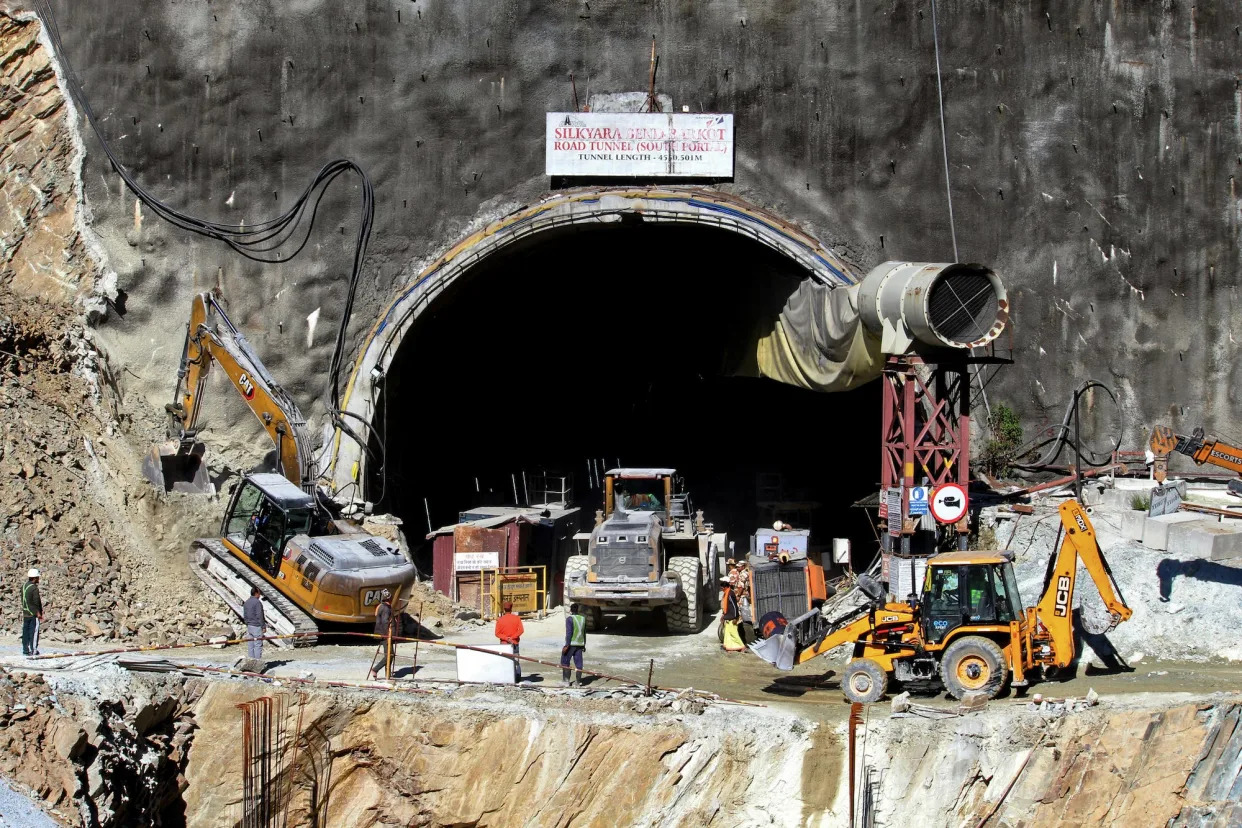
Rescue workers stand at an entrance of the under-construction road tunnel, days after it collapsed in the Uttarkashi district of India's Uttarakhand state.AFP via Getty Images
A partial tunnel collapse in the Indian state of Uttarakhand has left 40 workers trapped for a week.
Multiple efforts to drill through the debris to reach the workers have failed.
Rescuers have been able to send the workers radios, food, water, and oxygen through a pipe.
Rescuers have been working for over a week to extricate 40 workers trapped inside a collapsed tunnel in northern India, and are now shifting strategies following three failed attempts to drill through the debris.
The tunnel partially collapsed on November 12 after a landslide in the state of Uttarakhand. Rescue crews have been able to send radios, food, water, and oxygen to the workers through a pipe, according to The New York Times.
Rescuers have now made three attempts to drill through the debris to reach the workers from various angles, but all have failed, the BBC reported on Sunday. Officials told reporters the land around the tunnel was fragile, and drilling could risk more debris falling.
"We have decided to go with a pause-and-go approach to maintain the equilibrium," Anshu Manish Khalkho, director of state-run highway management company, said Friday, according to CNN. "It may look easy from the outside, but on-site we have to factor in the effects of the drilling vibrations on the fragile terrain."

Rescue workers gather at the site after a tunnel collapsed in the Uttarkashi district of India's Uttarakhand state.AFP via Getty Images
Officials have now identified a spot directly above the tunnel that rescuers will attempt to drill through, and workers are preparing a platform for the drilling machine. The officials told reporters the rescue could take an additional four or five days, according to the BBC.
One doctor on the site, who has been speaking with the trapped workers, said some of them have developed concerning symptoms such as headaches and vomiting.
"They are suffering from anxiety and gastritis. We sent medicines, dry fruits, chickpeas, and puffed rice," Dr. B.S. Pokriyal told CNN. "They kept asking us to get them out fast, so I spent some time counseling and motivating them."
Pokriyal added that the men have about 0.6 miles of space within the tunnel to walk around.
Before the landslide, the trapped workers had been building part of a national highway project intended to facilitate pilgrimages to the major Hindu shrines in Uttarakhand.
AFP
Sun, November 19, 2023

Rescue workers stand at an entrance of the under-construction road tunnel, days after it collapsed
Indian rescuers are considering opening a vertical shaft to free 41 men trapped in a collapsed tunnel after drilling at the site was paused over fears of further cave-ins and as efforts stretched into a second week.
Excavators have been removing earth, concrete and rubble from the under-construction tunnel in the northern Himalayan state of Uttarakhand since last Sunday after a portion of the tunnel collapsed.
Rescue efforts have been slowed by continued falling debris as well as repeated breakdowns of the crucial heavy drilling machines, with the air force having to twice airlift in new kit.
Drilling through the tonnes of debris was paused late Friday, after a cracking sound created a "panic situation", officials said.
Operations were then halted due to the possibility of "further collapse", said the government's highways and infrastructure company, NHIDCL.
"Every possible effort is being made," Minister of Road Transport Nitin Gadkari said Sunday, after visiting the site.
He said if the drilling machine was fixed, they could reach the men by Tuesday, but said teams were also considering multiple alternative routes.
Relatives of those trapped, who spoke to the men via radio, said conditions were grim and morale low.
"They are in tears... they have started asking us whether we are lying about the rescue efforts being made to save them," one relative told reporters late Saturday, without giving their name.
- 'Bring those 41 men home' -
Engineers had been trying to horizontally drive a steel pipe about 90 centimetres (nearly three feet) wide through the debris -- enough for the increasingly desperate trapped men to squeeze through.
Bhaskar Khulbe, a senior government official involved in the rescue operations, said teams were now considering digging an entirely new shaft, including from above.
That could involve digging down more than 100 metres (330 feet), but a track would have to be constructed to even bring the heavy diggers to that site.
The Press Trust of India news agency reported initial "preparations to drill a vertical hole from the top of the hill" had begun, as an alternative route out.
Rescuers have been communicating with the trapped workers by radio, while food, water, oxygen and medicine have also been sent to them via a 15-centimetre-wide (six-inch) pipe.
Tunnel expert Arnold Dix, an independent disaster investigator and president of the International Tunnelling and Underground Space Association, said he was on his way to India after being asked to help.
"We are discussing right now our options for the safe rescue of these men," Dix told India Today.
Experts have warned about the impact of extensive construction in Uttarakhand, where large parts of the state are prone to landslides.
Dix said the tunnel was in "one of the most difficult areas", but said he was confident they would be rescued.
"We are going to bring those 41 men home," he said.
Villagers have set up a Hindu temple at the mouth of the tunnel to the local god, Boukhnag, saying the original temple had been moved during construction.
Some villagers told reporters they blamed the tunnel collapse on the fact that the initial temple was destroyed.



